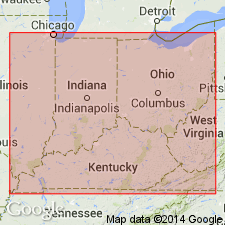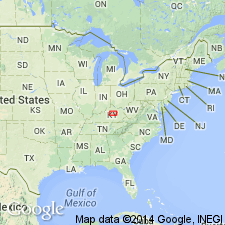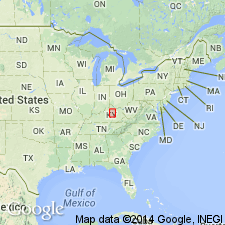
- Usage in publication:
-
- Nicholas bed
- Modifications:
-
- Named
- Dominant lithology:
-
- Limestone
- AAPG geologic province:
-
- Cincinnati arch
Summary:
Pg. 209, 210, 294, 297. Nicholas bed of Cynthiana formation. The coarse-grained limestone, with relatively few fossils, forming top bed of Cynthiana formation; 35 feet thick in Nicholas County, Kentucky, but decreases along Ohio River, where the limestones become more argillaceous, fine-grained layers more frequent, and fossils more abundant. Underlies Fulton layer. [On p. 209 and 210 author states it overlies Point Pleasant, "which term should be restricted to lower part of exposures at Point Pleasant, as intended by Prof. Orton." On p. 295 and 297 the Point Pleasant seems to be divided into Greendale and Perryville beds, and the Nicholas bed is described as resting on Greendale. Foerste repeated latter classification in 1910 and 1912.] Age is considered to be Middle Ordovician.
Named for Nicholas Co., KY, where it is fully developed southwest of Pleasant Valley.
Source: US geologic names lexicon (USGS Bull. 896, p. 1497); supplemental information from GNU records (USGS DDS-6; Reston GNULEX).

- Usage in publication:
-
- Nicholas Limestone Member*
- Modifications:
-
- Revised
- Dominant lithology:
-
- Limestone
- AAPG geologic province:
-
- Cincinnati arch
Summary:
Nicholas Limestone Member reassigned to Lexington Limestone. Composed in large part of tabular beds of coarse-grained and poorly fossiliferous calcarenite.
Source: GNU records (USGS DDS-6; Reston GNULEX).

- Usage in publication:
-
- Nicholas Bed*
- Modifications:
-
- Revised
- Age modified
- AAPG geologic province:
-
- Cincinnati arch
Summary:
The Nicholas is reduced in rank to the Nicholas Bed of the Tanglewood Limestone Member of the Lexington Limestone. Age is changed from Middle Ordovician to Late Ordovician.
Source: GNU records (USGS DDS-6; Reston GNULEX).

- Usage in publication:
-
- Nicholas Bed*
- Modifications:
-
- Age modified
- AAPG geologic province:
-
- Cincinnati arch
Summary:
Figure 3 shows Nicholas Bed of Tanglewood Limestone Member of Lexington Limestone to be of Champlainian (Shermanian) age, but boundary between Shermanian and Edenian Stages (and therefore the top of the Nicholas) is queried.
Source: GNU records (USGS DDS-6; Reston GNULEX).
For more information, please contact Nancy Stamm, Geologic Names Committee Secretary.
Asterisk (*) indicates published by U.S. Geological Survey authors.
"No current usage" (†) implies that a name has been abandoned or has fallen into disuse. Former usage and, if known, replacement name given in parentheses ( ).
Slash (/) indicates name conflicts with nomenclatural guidelines (CSN, 1933; ACSN, 1961, 1970; NACSN, 1983, 2005, 2021). May be explained within brackets ([ ]).

